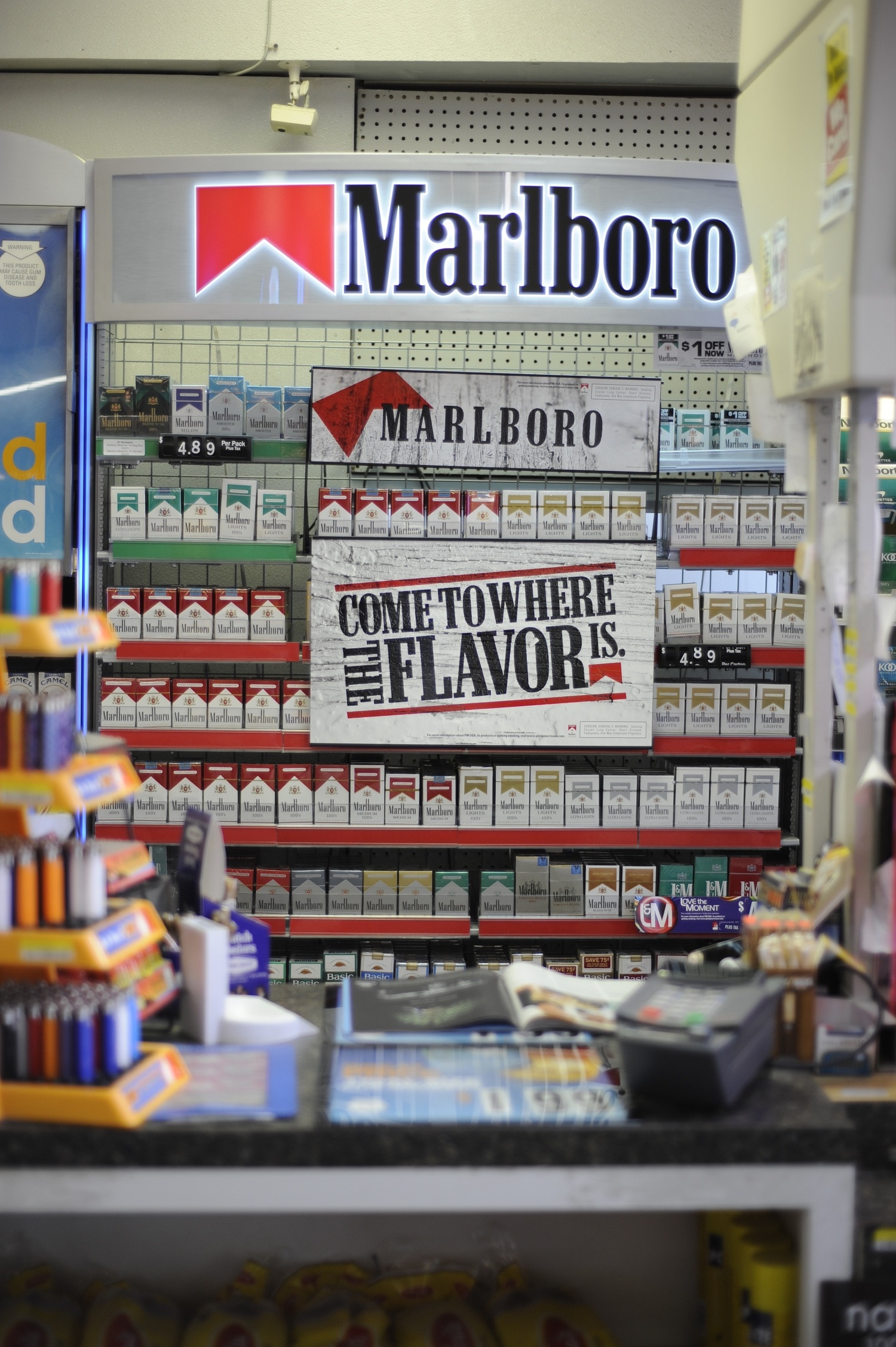Welcome to CounterTobacco.org’s “News and Research Roundup!” Each month we post a summary of the latest research, reports, and news stories on counteracting tobacco product sales and marketing at the point of sale (POS). Keeping up with what’s happening in the POS movement all across the country can help you choose policies and strategies that work best for your community. New research can help provide support for your work and evidence for the importance of the “War in the Store.” Have a story you don’t want us to miss? E-mail it to us!
New Research
Point-of-Sale Advertising
- Convenience store visitors recall cigarette advertisements even if they do not purchase cigarettes, Journal of Public Health
 This study surveyed over 1000 visitors to three convenience stores in Seoul, Korea as they exited the stores. While only 23.4% of participants recalled seeing an advertisement for cigarettes in the store they just visited, 55.2% could pick the advertisement out correctly as one that was present in the store from a card of options. Those who could recall the advertisement without a cue were younger, visited convenience stores more times per week, and were more likely to be current smokers. Free recall was also associated with a more positive attitude towards cigarette advertisements. This study indicates that individuals who are exposed to tobacco advertisements may unconsciously store the information, and repeated exposure to the advertisements may help maintain positive attitudes towards them, even when individuals do not remember the content of the ads.
This study surveyed over 1000 visitors to three convenience stores in Seoul, Korea as they exited the stores. While only 23.4% of participants recalled seeing an advertisement for cigarettes in the store they just visited, 55.2% could pick the advertisement out correctly as one that was present in the store from a card of options. Those who could recall the advertisement without a cue were younger, visited convenience stores more times per week, and were more likely to be current smokers. Free recall was also associated with a more positive attitude towards cigarette advertisements. This study indicates that individuals who are exposed to tobacco advertisements may unconsciously store the information, and repeated exposure to the advertisements may help maintain positive attitudes towards them, even when individuals do not remember the content of the ads.- Learn more about restricting tobacco advertising.
- Child awareness of and access to cigarettes: impact of the point-of-sale display ban in England, Tobacco Control
- When England implemented a policy that banned the display of tobacco products in small shops (2012) 89.9% of children aged 11-15 years old reported seeing displays of cigarettes. That decreased to 86% after a display ban in all stores was implemented in 2015, and the percentage of children who reported buying cigarettes from a store as their regular source decreased from 57% in 2010 to 39.8% in 2016. However, the perception of ease of obtaining cigarettes did not change significantly among children that same age, nor did the percentage of regular child smokers who reported being refused the sale of cigarettes at their last attempt (31.2%). This indicates that while display bans do reduce exposure to tobacco products, enforcement of age-of-sale laws and tobacco retailer licensing schemes may help further reduce youth access to tobacco products.
- Learn more about restricting product placement and displays.
- The magnitude and impact of tobacco marketing exposure in adolescents’ day-to-day lives: An ecological momentary assessment (EMA) study, Addictive Behaviors
 This study assessed real-time exposure to tobacco marketing via a smartphone-based survey with prompts 2-3 times a day. The participants, adolescent males ages 11-16 from both rural and urban Ohio, reported exposure to tobacco marketing an average of 1.9 times over a 10-day period. Participants were most frequently exposed to tobacco advertising at the point of sale, most often at convenience stores or gas stations. Those who were current tobacco users and those who live in rural areas both reported higher levels of exposure to tobacco marketing. In addition, those who reported greater exposure to tobacco advertising had more positive attitudes about tobacco advertising, higher rates of tobacco use, and were more likely to report that they would use tobacco products in the future.
This study assessed real-time exposure to tobacco marketing via a smartphone-based survey with prompts 2-3 times a day. The participants, adolescent males ages 11-16 from both rural and urban Ohio, reported exposure to tobacco marketing an average of 1.9 times over a 10-day period. Participants were most frequently exposed to tobacco advertising at the point of sale, most often at convenience stores or gas stations. Those who were current tobacco users and those who live in rural areas both reported higher levels of exposure to tobacco marketing. In addition, those who reported greater exposure to tobacco advertising had more positive attitudes about tobacco advertising, higher rates of tobacco use, and were more likely to report that they would use tobacco products in the future.
Menthol and Other Flavored Tobacco
- No surge in illicit cigarettes after implementation of menthol ban in Nova Scotia, Tobacco Control
- When the Canadian province of Nova Scotia banned the sale of menthol cigarettes in 2015, the tobacco industry warned of an increase in black market. However, the number of illicit cigarettes seized actually declined significantly from 2007/2008 to 2017/2018 and the volume seized remained stable after implementation of the ban with enforcement efforts remaining at the same level.
- Learn more about menthol tobacco products.
- Flavour capsule cigarette use among US adult cigarette smokers, Tobacco Control
 Flavor capsule cigarettes contain a crushable capsule located in or near the filter that releases flavoring when crushed. Menthol flavored capsules are the most common and are the only ones allowed in the United States. This study analyzing data from the US Population Assessment of Tobacco and Health survey from 2013-2014 found that usual use of flavor capsule cigarettes was most common among young adults (9.4% of smokers ages 18-24), and Hispanic young adults in particular (17.3% of Hispanic smokers ages 18-24). Those who used flavor capsules were also more likely to smoke less often, have started smoking later in life, and be less nicotine-dependent Those who used flavor capsule cigarettes also indicated that pack design and lower price were some of their reasons for using the product. These findings indicate that tobacco companies may be marketing capsule cigarettes as starter products.
Flavor capsule cigarettes contain a crushable capsule located in or near the filter that releases flavoring when crushed. Menthol flavored capsules are the most common and are the only ones allowed in the United States. This study analyzing data from the US Population Assessment of Tobacco and Health survey from 2013-2014 found that usual use of flavor capsule cigarettes was most common among young adults (9.4% of smokers ages 18-24), and Hispanic young adults in particular (17.3% of Hispanic smokers ages 18-24). Those who used flavor capsules were also more likely to smoke less often, have started smoking later in life, and be less nicotine-dependent Those who used flavor capsule cigarettes also indicated that pack design and lower price were some of their reasons for using the product. These findings indicate that tobacco companies may be marketing capsule cigarettes as starter products.- Learn more about flavored tobacco products.
E-cigarettes
- ENDS retailers and marketing near university campuses with and without tobacco-free policies, Tobacco Induced Diseases
 Electronic Nicotine Delivery System (ENDS) retailers were mapped within 1-4 miles of 33 university campuses in California, telephoned to confirm availability of e-cigarettes and/or e-liquids, and visited in person to assess retail marketing. Half of the universities had 10 or more ENDS retailers nearby. The most common ENDS retailers were convenience stores (42.5%). Nearly half (43.6%) of the ENDS retailers sold products marketed as zero-nicotine, and 28.1% had exterior marketing for ENDS. ENDS retailers near university campuses with established tobacco-free policies had less exterior advertising than the ENDS retailers near university campuses with recent or no tobacco-free policies.
Electronic Nicotine Delivery System (ENDS) retailers were mapped within 1-4 miles of 33 university campuses in California, telephoned to confirm availability of e-cigarettes and/or e-liquids, and visited in person to assess retail marketing. Half of the universities had 10 or more ENDS retailers nearby. The most common ENDS retailers were convenience stores (42.5%). Nearly half (43.6%) of the ENDS retailers sold products marketed as zero-nicotine, and 28.1% had exterior marketing for ENDS. ENDS retailers near university campuses with established tobacco-free policies had less exterior advertising than the ENDS retailers near university campuses with recent or no tobacco-free policies.- Learn more about e-cigarettes at the point of sale.
- The impact of flavor, device type and warning messages on youth preferences for electronic nicotine delivery system: evidence from an online discrete choice experiment, Tobacco Control
- In this online study, youth ages 14-17 were asked to choose one of two different ENDS products with varying characteristics from 9 different sets of two. Flavor had a stronger impact on choice than device type or warning message, with youth more likely to choose fruit/sweet/beverage flavored versions of ENDS. Participants who had never used ENDS were more likely to choose a product with menthol flavor than tobacco flavor and more likely to choose a modifiable vaping device over a cigarette-like device. However, warning messages reduced the probability that never-users would choose an ENDS product.
- The Future of Nicotine Regulation: Key Questions and Challenges, Nicotine & Tobacco Research
Sugar and Sweetness in Tobacco Products
- Knowledge and Awareness of Added Sugar in Cigarettes, Nicotine & Tobacco Research
- While tobacco companies commonly add sugar to cigarettes, which increases the toxic chemicals in cigarette smoke, most adults who smoke are unaware of this. A online experiment found that only 5.5% of adult smokers were aware that sugar is added to cigarettes and only 3.8% were aware that sugar increases toxins in cigarette smoke. However, several were interested in learning more about added sugar in cigarettes and some comments indicated that messages about added sugar may help motivate smokers to quit.
- News Story: Few smokers know about added sugar in cigarettes, Reuters
- Sweet taste potentiates the reinforcing effects of e-cigarettes, European Neuropsychopharmacology
- Research Letter: Presence of High-Intensity Sweeteners in Popular Cigarillos of Varying Flavor Profiles, JAMA Network
- News story: Study shows cigarillo flavors enhances by high-intensity sweeteners, Medical Xpress
Industry News
- To Grow Your Tobacco Profits, Think Strategically, Convenience Store News

- With E-Cigs in the Crosshairs, Altria Looks to Other Tobacco Products, Motley Fool
- Retailers in 5 States Feel Brunt of FDA Sting, CSP Daily News
- Behind the Curtain: Retailer Offers Insight on Lawmakers, Opposition, CSP Daily News
- Juul, the popular e-cig startup under growing FDA scrutiny, says removing flavors is ‘on the table’ among other things, Tech Crunch
- Swedish Match debuts strong snus styles, Winston-Salem Journal
- Philip Morris International Unveils Next-Gen iQOS, Convenience Store News
POS Policy in the Media
Tobacco 21
- Hartford Becomes First Municipality in State to Raise Tobacco Purchasing Age to 21, Hartford Courant
- Age to Buy Tobacco Products In San Antonio Raised to 21, Texas Public Radio
- Putnam Raises Tobacco Buy to 21, The Highlands Current
- Excelsior raises tobacco sales age to 21 and restricts access near schools, Sun Sailor
- Haverhill increases smoking age, Eagle-Tribune
- Barrington becomes latest Lake County village to raise purchasing age of tobacco products to 21, Barrington Courier-Review
- Health Groups Announce “Moonshot” Plan to Cut Oklahoma Smoking Rate in Half, Public Radio Tulsa
- Altria’s support for age 21 minimum draws mixed reactions, Winston-Salem Journal
Flavored Tobacco
Court upholds Yarmouth policy on tobacco sales, Yarmouth Wicked Local
- Wilmington limits locations for flavored tobacco sales, Lowell Sun
- Helena commission advances ban on self-service tobacco displays, but nixes other restrictions, Helen Air
- Belmont to explore flavored tobacco rules, The San Mateo Daily Journal
- Businesses hurt by flavored tobacco ban call for restitution from city, San Francisco Examiner
- Snuffed out? Sacramento City Council to vote on flavored tobacco ban this year, Sacramento Bee
- Marin puts flavored tobacco ban back in the pipeline, Marin Independent Journal
Disparities
- Are Black Kids Still Falling for the Hype?, Huffington Post
- How Tobacco Companies Target Minorities, Urban Milwaukee
E-cigarettes
 FDA Seizes Documents from E-Cigarette Maker Amid Crackdown on Flavored Vapes, NPR
FDA Seizes Documents from E-Cigarette Maker Amid Crackdown on Flavored Vapes, NPR - E-Cigarette Maker Juul Files Complaints Against ‘Copycat Products,’ Reuters
- Study: E-Cigarette Injuries Drastically Underestimated, Med Page Today
- FDA investigating whether dozens of e-cigarette products are being illegally marketed, Washington Post
- Adding flavors to e-cigarette liquids changes chemistry, creates irritants, EurekAlert!
- FDA to consider limiting e-cigarette sales to vape shops to curb youth use, CNBC
- E-cigarette company Juul boosts lobbying spending by 167 percent amid FDA scrutiny, USA Today
- Altria to Stop Selling Some E-Cigarette Brands That Appeal to Youths, New York Times
Licensing
- Lakewood considering a licensing system for tobacco retailers, Lakewood Sentinel
- Ridgewood plans to restrict vape shops, ban weed shops, NorthJersey.com
Find more stories in last month’s News and Research Roundup.
Know of a story that we missed? Email us, and we’ll be sure to include it in next month’s roundup!


